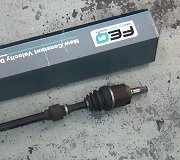It's me again. After 400,000 miles, I had to replace the driver's side half shaft on my '88 Grand Caravan. Found out a brand new one from O'Reilley's was only $65.00. As it fit so many different years, it came with an anti-lock brake tone wheel on the outer CV joint. I had to tap that off because it interfered with the splash shield.
There is a different problem that can cause a harsh steering wheel oscillation when under load, but only up to a certain speed. It's worse when turning, as when leaving a parking lot and accelerating onto the road. It's caused by wear inside the inner CV joint housing. To identify that, you have to disassemble the joint to inspect the six highly-polished rolling surfaces. If you can feel the slightest irregularity, you really have a bad one. More commonly, you have to wipe the grease off those six surfaces, then shine a light in there and look at the reflections. This is the same as admiring a beautiful paint job on a classic car, but then you can see the waves in the reflections below the doors. The slight dip you can see in the CV joint is normally much too subtle to feel. For that reason, a lot of rebuilders don't catch them, then they reuse that housing on the rebuilt shaft. My fear is going through all the work of replacing the shaft, then I end up having to do it over. That won't happen with a new shaft.
For the record, I don't know why, but of the dozen or so I ran into at the dealership, only one was caused by the driver's side shaft. All the others were caused by the right shaft. As the shaft rotates and goes through length changes as the suspension moves up and down, the three large rollers inside the joint roll back and forth. They bind when trying to roll through the worn area, then rather than rolling freely, they cause the shaft to push and pull on the spindle, ball joint, and lower control arm. Being mounted on rubber bushings, the tugging action is transmitted to the outer tie rod end and the rest of the steering linkage. This is worse under load, and it's why it is felt in the steering wheel. By the time you reach 35 to 45 mph, the load is less so the rollers resume running back and forth freely. That oscillation will also stop the instant you let off the accelerator.
My entire reason for sharing this wondrous story is to validate the desirability of using a new half shaft. Cost is no longer a factor. A used shaft, or a rebuilt one, can lead to new or worse problems than what you're trying to solve.
Tuesday, October 31st, 2023 AT 3:46 PM


















